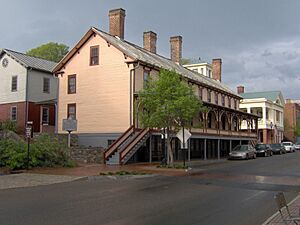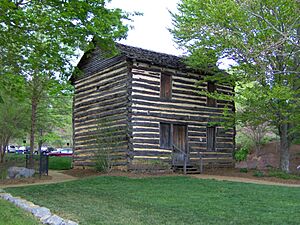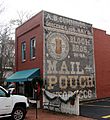Jonesborough, Tennessee facts for kids
Quick facts for kids
Jonesborough
|
||
|---|---|---|
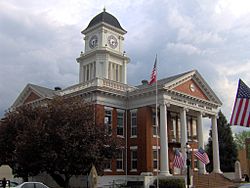
Washington County Courthouse in Jonesborough
|
||
|
||
| Nickname(s):
Tennessee's Oldest Town, Storytelling Capital of the World
|
||
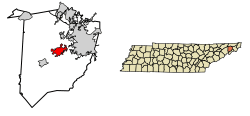
Location of Jonesborough in Washington County, Tennessee.
|
||
| Country | United States | |
| State | Tennessee | |
| County | Washington | |
| Incorporated | 1779 | |
| Named for | Willie Jones | |
| Government | ||
| • Type | Mayor-council-administrator | |
| Area | ||
| • Total | 5.32 sq mi (13.79 km2) | |
| • Land | 5.32 sq mi (13.79 km2) | |
| • Water | 0.00 sq mi (0.00 km2) | |
| Elevation | 1,729 ft (527 m) | |
| Population
(2020)
|
||
| • Total | 5,860 | |
| • Density | 1,100.68/sq mi (424.98/km2) | |
| Time zone | UTC-5 (Eastern (EST)) | |
| • Summer (DST) | UTC-4 (EDT) | |
| ZIP code |
37659
|
|
| Area code(s) | 423 | |
| FIPS code | 47-38540 | |
| GNIS feature ID | 2405919 | |
Jonesborough (pronounced "JONES-buh-ruh") is a historic town in Washington County, Tennessee. It is the main town, or county seat, of Washington County. In 2020, about 5,860 people lived there. Jonesborough is known as "Tennessee's oldest town."
This town is part of the Johnson City metropolitan area. This area is also a part of the larger "Tri-Cities" region.
Contents
History of Jonesborough
Early Beginnings and Statehood
Jonesborough was founded in 1779 by European settlers. This was 17 years before Tennessee became a state. At that time, the area was part of North Carolina. The town was named after Willie Jones. He was a North Carolina lawmaker who supported expanding the state westward.

For a while, the town's name was spelled "Jonesboro." However, it later went back to its original spelling, "Jonesborough."
Jonesborough was first part of the Washington District. In 1784, it became the capital of the State of Franklin. This was an independent area named after Benjamin Franklin. However, the U.S. Congress never officially recognized Franklin as a state. North Carolina took control of the area again in 1788.
Abolitionist Movement and Newspapers
In the early 1800s, Tennessee and other border states were important places for people who wanted to end slavery. These people were called abolitionists. The Tennessee Manumission Society, a group against slavery, started in 1815. East Tennessee, where Jonesborough is, had many people who supported the Union during the Civil War. These were often farmers with small farms. They had fewer enslaved people compared to other parts of Tennessee.
Elihu Embree of Jonesborough started a newspaper called Manumission Intelligencier in 1819. The next year, he changed its name to The Emancipator. This newspaper was the first in America to focus only on ending slavery. Jonesborough became a center for the abolitionist movement.
In the 1840s, another newspaper, the Jonesborough Whig, was published here. Its publisher was William G. "Parson" Brownlow. He moved the paper from another town to Jonesborough. Brownlow and a rival editor, Landon Carter Haynes, often argued in their newspapers. They even had fights in the streets of Jonesborough! Both men tried to stop the other's political plans. Haynes left the newspaper business in 1845. Brownlow, who later became governor, moved his paper to Knoxville in 1849.
From 1865 to 1873, the town had a newspaper called The Union Flag. Other papers like the Herald & Tribune and the Tennessee Echo were also published in Jonesborough during this time.
The Cholera Outbreak of 1873
In the summer of 1873, a serious illness called cholera spread. It started in New Orleans and moved along the Mississippi River. This was part of a larger worldwide outbreak. The disease spread quickly in towns because they did not have good sanitation systems.
People were very scared of cholera because many who got sick did not recover. They did not know how the disease spread. Jonesborough residents heard about cases in nearby towns. The first case in Jonesborough was on July 14. Many people had already left town, hoping to stay healthy. The local newspaper stopped publishing for weeks as the illness spread.
Of the people who stayed in Jonesborough, many became very sick. Sadly, some died, and others recovered. The town received help from other places. Within a month, the illness mostly ended. People slowly returned to their town, which had been deeply affected by the difficult month.
Modern Tourism and Storytelling
Today, Jonesborough is a popular place for "heritage tourism." This means people visit to see its history. It is Tennessee's oldest town and has many old, beautiful buildings. Local groups work to protect these historic places. The town's museum shares stories about its past, including small-scale tobacco farming. The historic Chester Inn, built in 1797, is still standing in downtown Jonesborough.
The Jonesborough Historic District was added to the National Register of Historic Places in 1969. The oldest building in town, the Christopher Taylor House, was built in 1777. It was moved to a park within the historic district.
Jonesborough is also home to the International Storytelling Center. This center hosts the annual National Storytelling Festival. This festival happens every October. It celebrates the tradition of storytelling from the Appalachian mountains. People from all over the world come to hear stories. Large tents are set up in parks, and storytellers perform on stages. Sometimes, passing trains briefly interrupt the stories! Famous storytellers like Carmen Agra Deedy and Syd Lieberman have performed here. The festival even inspired a storytelling degree program at East Tennessee State University.
Geography of Jonesborough
Jonesborough is located where the water from the Watauga River and the Nolichucky River areas meet. The Watauga River is about 10 miles (16 km) northeast of Jonesborough. The Nolichucky River is about 10 miles (16 km) southwest. Little Limestone Creek, a stream in the town, flows into the Nolichucky River.
The town is surrounded by small hills and long ridges. These are common in the Appalachian Ridge-and-Valley Province. The main Appalachian Mountains are just a few miles southeast of Jonesborough.
Jonesborough is at the meeting point of two main roads. Andrew Johnson Highway (which is U.S. Route 321 and U.S. Route 11E) connects Jonesborough to Greeneville and Johnson City. State Route 81 connects Jonesborough to Interstate 81 and Interstate 26.
The United States Census Bureau says that Jonesborough covers about 4.3 square miles (11.1 km2) of land. There is no water area within the town limits.
Population Changes
| Historical population | |||
|---|---|---|---|
| Census | Pop. | %± | |
| 1880 | 895 | — | |
| 1890 | 937 | 4.7% | |
| 1900 | 854 | −8.9% | |
| 1910 | 806 | −5.6% | |
| 1920 | 815 | 1.1% | |
| 1930 | 931 | 14.2% | |
| 1940 | 976 | 4.8% | |
| 1950 | 1,126 | 15.4% | |
| 1960 | 1,148 | 2.0% | |
| 1970 | 1,510 | 31.5% | |
| 1980 | 2,829 | 87.4% | |
| 1990 | 3,091 | 9.3% | |
| 2000 | 4,168 | 34.8% | |
| 2010 | 5,051 | 21.2% | |
| 2020 | 5,860 | 16.0% | |
| Sources: | |||
The population of Jonesborough has grown over the years. In 1880, there were 895 people. By 2020, the population had grown to 5,860 people.
2020 Census Information
In 2020, there were 5,860 people living in Jonesborough. There were 2,064 households and 1,397 families.
| Race | Number | Percentage |
|---|---|---|
| White (non-Hispanic) | 5,151 | 87.9% |
| Black or African American (non-Hispanic) | 259 | 4.42% |
| Native American | 10 | 0.17% |
| Asian | 57 | 0.97% |
| Pacific Islander | 3 | 0.05% |
| Other/Mixed | 216 | 3.69% |
| Hispanic or Latino | 164 | 2.8% |
Education in Jonesborough
Jonesborough is part of the Washington County School District. This district has nine elementary schools, two middle schools, and three high schools.
Schools located in Jonesborough include:
- Jonesborough Elementary School
- David Crockett High School
- Jonesborough Middle School
Starting in the 2023-2024 school year, Jonesborough Elementary and Middle Schools will combine into a new K-8 school.
Fun Activities and Recreation
The southern Appalachian Mountains offer many outdoor activities. You can go hiking, biking, hunting, or fishing. There's also whitewater rafting, golf, and rock climbing. You can even try zip lining or exploring caves!
The Jonesborough Repertory Theatre puts on community plays. They also offer workshops for young actors. Jennifer Schmidt is the current artistic director.
Local Legend of Andrew Jackson
There's a local story that the ghost of Andrew Jackson sometimes appears near the Christopher Taylor House. Andrew Jackson later became a U.S. president. In 1788, he spent several months in Jonesborough. He was practicing law while waiting to travel to Nashville. During that time, he stayed in a cabin owned by Major Christopher Taylor. This cabin was moved in 1974 to a park in the town's historic district.
Famous People from Jonesborough
- Walter P. Brownlow: A U.S. congressman.
- Cornelia Deaderick Glenn: She was the First Lady of North Carolina.
- James W. Deaderick: He was the Chief Justice of the Tennessee Supreme Court from 1876 to 1886.
- Alfred Eugene Jackson: A farmer and merchant who helped start the East Tennessee and Virginia Railroad. He was a general in the Confederate army during the Civil War.
- Thomas H. McCray: A Confederate Army officer born here.
- Bernie Moore: A College Football Hall of Fame coach born here.
- Thomas Amos Rogers Nelson: A congressman and Southern Unionist.
- G.C. Spencer: A former NASCAR race car driver.
Images for kids
See also
 In Spanish: Jonesborough (Tennessee) para niños
In Spanish: Jonesborough (Tennessee) para niños



